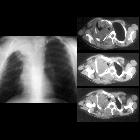plexiform neurofibroma



































Plexiform neurofibroma is an uncommon variant of neurofibroma, a benign tumor of peripheral nerves (WHO grade I), arising from a proliferation of all neural elements. Plexiform neurofibromas are essentially pathognomonic of neurofibromatosis type 1 (NF1). Unlike small sporadic localized neurofibromas and diffuse cutaneous neurofibromas (both discussed separately), these tumors are at significant risk of eventual malignant transformation.
Terminology
There is variable use and some confusion about the distinction between plexiform neurofibroma and diffuse cutaneous neurofibroma, with some sources not clearly distinguishing between the two. Generally, plexiform neurofibromas are deeper lesions affecting nerves and plexus. The two may, however, co-exist .
Importantly it appears that diffuse cutaneous neurofibromas may not be as closely associated with neurofibromatosis type 1 (NF1), nor have the same risk of malignant transformation . The distinction is thus important.
Epidemiology
Plexiform neurofibromas are usually diagnosed in early childhood. They are found in approximately 30% of patients with NF1.
Clinical presentation
Clinically, it presents as a subcutaneous mass which feels like a "bag of worms". Most of the time, it is a superficial cutaneous/subcutaneous lesion, but it can occur almost anywhere in the body. Symptoms may be related to local mass effect.
Pathology
Plexiform neurofibromas diffusely involve long nerve segments and its branches, often extending beyond the epineurium into the surrounding tissue.
Immunophenotype
Immunohistochemistry demonstrates findings in keeping with a neurogenic origin, including .
- S100: positive (fewer reactive cells than in schwannoma)
- SOX10: positive (fewer reactive cells than in schwannoma)
- neurofilament: only positive in entrapped axons
Radiographic features
CT
Non-specific infiltrative subcutaneous lesions.
MRI
Reported signal characteristics include:
- T1: hypointense
- T2: hyperintense +/- hypointense central focus (target sign)
- T1 C+: mild enhancement
Treatment and prognosis
Although generally benign tumors, there is a significant potential for malignant transformation, which occurs in 5-10% of larger tumors . If complete resection is possible, then a cure can be effected, however, due to the infiltrating nature of these tumors, such a resection is usually not possible.
History and etymology
The term plexiform comes from the infiltrative growth pattern that, histologically, looks like a plexus or a network. Plex- originates from the Latin verb plectere meaning "to plait" or "interweave".
It is typically associated with tumors of neural derivation. Plexiform neurofibromas are considered the prototype of the plexiform pattern .
Differential diagnosis
On imaging consider:
- sarcoma
- plexiform schwannoma
- lymphatic malformation
- venous malformation
Siehe auch:
und weiter:

 Assoziationen und Differentialdiagnosen zu plexiformes Neurofibrom:
Assoziationen und Differentialdiagnosen zu plexiformes Neurofibrom:


